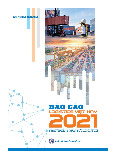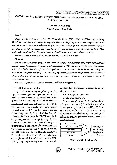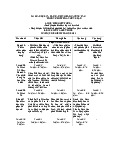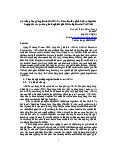



Preview text:
Motor Carriers 175
Network Truck Stops Many motor carriers make contracts with a limited number of truck
stop chains to reduce their fuel procurement costs. The basic approach here is to make a
contract with a specific truck stop chain (for example, Flying J and Pilot), such that a car-
rier commits to a certain (minimum) amount of fuel purchases within a given time period
from the chain, and receives a price discount in exchange. If the carrier fails to purchase the
committed amount within the time period, the contract becomes void. The truck stops with
which a carrier has such purchase contracts are cal ed the carrier’s “network truck stops.”
Typical y, the network truck stops wil issue fueling cards to the carrier drivers, so that when
drivers buy fuel within the network, they automatical y receive the price discount at the
pump. Drivers are encouraged to refuel only at network truck stops (so that the carrier can
meet or exceed the commit ed purchase quantity), unless it is absolutely necessary for them
to buy fuel outside the network (for example, when fuel is low and there are no network truck
stops within 100 miles). Note that drivers have incentives to refuel at network truck stops
too, because if they buy fuel outside the network, they cannot use fueling cards, meaning
that they may need to tentatively pay the fuel cost (which may be in excess of $500 if they top off) out of their pocket.
There are three methods of setting price discounts with truck stop chains. The first is
the “retail minus” method. This method gives discount to carriers by subtracting a prede-
termined amount from the normal retail price (for example, “retail minus five” means that
a carrier’s purchase price is five cents less than the normal retail price at the pump). The
second is the “cost plus” method. Under this method, the discounted price is computed
by first estimating the truck stop’s cost of fuel (cost of goods sold, which includes the cost
of fuel per se at the nearest pipeline, cal ed the rack price, cost of transporting fuel from
pipeline to the truck stop, and other miscel aneous cost items), and then adding the profit
margin of the truck stop. For example, “cost plus three” means that the discounted price is
the truck stop’s cost of fuel plus three cents. The third is the “best of ” method, which is a
hybrid of the above two methods, such that the discount price is determined by the lower
of the prices given by the two methods. For example, “best of retail minus five or cost plus
three” means that the price is determined by first computing the price based on the “retail
minus five” and “cost plus three” methods, and then choosing the lower of the two prices. In
many cases, a carrier approaches multiple truck stop chains by first providing the commit ed
purchase quantity, and then soliciting for price quotes based on the committed purchase
quantity. After obtaining responses from the chains, the carrier can either choose the chain
that provided the best deal, or continue to negotiate price discounts based on the results of
the responses from chains (execute the second round of bidding based on the results of the first round bidding).
Bulk Purchasing Some large motor carriers have a network of terminals across the United
States. These terminals typical y have fuel pumps so that their trucks can refuel at these ter-
minals. Since these terminals refuel many trucks, they buy large amounts of fuel from fuel
suppliers on a daily basis, meaning that they can receive sizable quantity discounts from sup-
pliers. Some carriers claim that if their trucks refuel at these terminals rather than at truck
stop chains, their fuel cost can become considerably lower, because this wil al ow them to
avoid paying “profits” for truck stop chains. As such, these carriers normal y encourage their
drivers to refuel at these terminals whenever possible. They, however, discourage drivers to
use these facilities when it requires trucks to deviate considerably, say more than 20 miles,
off the shortest route between origin and destination.
Equipment Adjustments One of the most widely used approaches to enhance fuel efficiency
of trucks is the adjustment of equipment (tractor or trailer). These adjustments wil improve
Copyright 2019 Cengage Learning. All Rights Reserved. May not be copied, scanned, or duplicated, in whole or in part. Due to electronic rights, some third party content may be suppressed from the eBook and/or eChapter(s).
Editorial review has deemed that any suppressed content does not materially affect the overall learning experience. Cengage Learning reserves the right to remove additional content at any time if subsequent rights restrictions require it. 176 CHAPTER 5
fuel consumption rates of trucks via enhancing air drags and low rolling resistance. Such
adjustments include the use of trailer and cab roof fairings, trailer side skirts, aerodynamic
side mirrors, and SmartWay certified tires. Some articles claim that these adjustments can
give 1 percent to 6 percent savings in fuel cost.24
Large Fuel Tank Typical y, heavy-duty trucks (such as U.S. Class 8 trucks) are equipped with
fairly large fuel tanks that can carry 200 to 240 gal ons. Some motor carriers, however, are
instal ing even larger tanks to their vehicles to save fuel costs. This is because many carriers
believe that having large tanks would help them reduce fuel procurement costs. The basic
logic behind this approach is that, by having large fuel tanks, many trucks can possibly avoid
buying fuel in regions where fuel prices are expensive. If, for example, a truck is making a
round trip from a region where the fuel price is cheap (region A) to a region where the fuel
price is expensive (region B), the truck may need to buy fuel before completing the round trip
(possibly at or near region B) if it has a smal fuel tank, whereas it may be able to finish the
round trip without any refueling (avoid buying fuel at or near region B) if it has a large tank.
Note, however, that there is one disadvantage associated with this approach; that is, recent
studies have shown that a truck with more fuel in its tank (thus with more fuel weight) wil
require more fuel burns.25 As such, the net benefit of this approach may be relatively smal .
Prevent Out-of-Fuel Occasions Sometimes, trucks run out of fuel on the road for multiple
reasons. Occasionally, this may be due to mechanical problems such as a fuel indicator
malfunction. In most cases, however, this happens because of drivers’ negligence of proper
fuel indicator monitoring, or drivers’ reluctance to stop for refueling (many drivers dislike
making frequent fuel stops, as this tends to delay the ETA—estimated time of arrival at
destination). When this happens, carriers usual y have to dispatch a rescue vehicle, which
supplies enough fuel to the “out-of-fuel” truck for it to move to the next available truck
stop. Some carriers estimate the cost of this rescue vehicle to be around $200 per dispatch.
Since this is costly, many motor carriers are creating company policies and guidelines for
truck drivers that specify when they have to stop to purchase fuel. Typical y these guidelines
suggest that when the fuel level reaches at or below 20 percent of tank capacity (for example,
40 gal ons for a truck with a 200-gal on tank) drivers must stop for refueling. Some carriers
have instal ed “engine monitors” to their vehicles, which al ow managers to monitor trucks’
engine conditions, including fuel level, from the headquarters at all times.
Prevent Fuel Leakage and Theft Motor carriers lose fuel because of fuel leakage and drivers’
fuel theft. It may be a surprise to some readers that some (but not the majority of) drivers
steal fuel from their trucks, but this actual y happens (this resembles the situation for retail
stores where products are lost due to employee theft). Since the loss of fuel because of these
reasons increases the cost of carriers without providing any benefit, carriers are trying to
avoid such losses. They are attempting to minimize fuel leakage from tanks by performing
frequent preventive maintenance of their vehicles, and minimize driver theft by perform-
ing driver education and fuel monitoring (ensuring that the fuel spent for a given trip is in
agreement with the miles driven).
Fuel Optimizer Fuel optimizers are software products widely used by TL carriers to reduce
the fuel procurement cost of their fleet at the point of purchase. It is wel known that fuel
prices vary (often substantially) from one truck stop to another, even within the same
region. The basic concept of the fuel-optimizer products is to take advantage of such price
variances across locations (truck stops) to reduce the cost of buying fuel. These products
first download the latest price data of nearly all the truck stops in the United States and
Canada (which are updated daily), and then compute the optimal fueling policy for a given
Copyright 2019 Cengage Learning. All Rights Reserved. May not be copied, scanned, or duplicated, in whole or in part. Due to electronic rights, some third party content may be suppressed from the eBook and/or eChapter(s).
Editorial review has deemed that any suppressed content does not materially affect the overall learning experience. Cengage Learning reserves the right to remove additional content at any time if subsequent rights restrictions require it. Motor Carriers 197 CASE 5-2 Cyclone Transportation
Cyclone Transportation is a medium-sized truckload carrier based in Ohio, United States.
You are a procurement manager of this company, whose main responsibility is the procure-
ment of diesel fuel for the company’s fleet of Class 8 trucks.
You have been assigned to negotiate the fuel contract for the Perrysburg, Ohio market.
Your assistant has collected the fol owing per gal on information concerning the major truck
stop chains (A, B, and C) around that area. You wil use this information to analyze each fuel vendor’s proposed contract. CHAIN A RETAIL PRICE RETAIL PRICE TRUCK STOP COST DATE INCL. STATE TAX NO STATE TAX NO STATE TAX 10/20/17 2.822 2.568 2.514 10/21/17 2.810 2.557 2.421 10/22/17 2.938 2.674 2.460 10/23/17 2.958 2.692 2.738 10/24/17 2.927 2.664 2.570 CHAIN B Retail price Retail price Truck stop cost Date (incl. state tax) (no state tax) (no state tax) 10/20/17 2.972 2.705 2.475 10/21/17 2.946 2.681 2.557 10/22/17 2.922 2.659 2.606 10/23/17 2.831 2.576 2.439 10/24/17 2.846 2.590 2.550 CHAIN C Retail price Retail price Truck stop cost Date (incl. state tax) (no state tax) (no state tax) 10/20/17 2.956 2.690 2.618 10/21/17 2.844 2.588 2.362 10/22/17 2.794 2.543 2.466 10/23/17 2.982 2.714 2.516 10/24/17 2.802 2.550 2.353
Copyright 2019 Cengage Learning. All Rights Reserved. May not be copied, scanned, or duplicated, in whole or in part. Due to electronic rights, some third party content may be suppressed from the eBook and/or eChapter(s).
Editorial review has deemed that any suppressed content does not materially affect the overall learning experience. Cengage Learning reserves the right to remove additional content at any time if subsequent rights restrictions require it. 198 CHAPTER 5
Your company purchases approximately 100,000 gal ons of diesel fuel each month in the
Perrysburg market. Chains A, B, and C have each sent you a contract in hopes of winning
your company’s business. The contract proposals are listed below. BIDS SUPPLIER METHOD RETAIL DISCOUNT PUMP FEE TRANSACTION FEE A Cost plus 0.02 0.25 B Retail minus 0.03 0.00 C Best of 0.02 0.03 0.50
As discussed in this chapter, the price of the cost-plus method is given by the truck
stop cost plus pump fee, while that of the retail-minus method is given by the retail price
(without state tax) minus retail discount. There is also a transaction fee associated with
purchasing fuel from each of the vendors. This is a one-time cost per transaction, meaning
that your trucks must pay this cost every time they buy fuel, regardless of the amount of
fuel purchased. The average fuel purchase quantity of your drivers (per transaction or per
refueling stop) is roughly 100 gal ons. CASE QUESTIONS
1. Given the proposed contracts, what is your company’s average cost of fuel per gal on with each of the fuel vendors?
2. Which truck stop chain should you choose if your goal is to minimize fuel cost?
3. Chain B real y wants your business and says they wil do anything to obtain it. What
should their retail discount be in order to obtain your business?
Copyright 2019 Cengage Learning. All Rights Reserved. May not be copied, scanned, or duplicated, in whole or in part. Due to electronic rights, some third party content may be suppressed from the eBook and/or eChapter(s).
Editorial review has deemed that any suppressed content does not materially affect the overall learning experience. Cengage Learning reserves the right to remove additional content at any time if subsequent rights restrictions require it.




